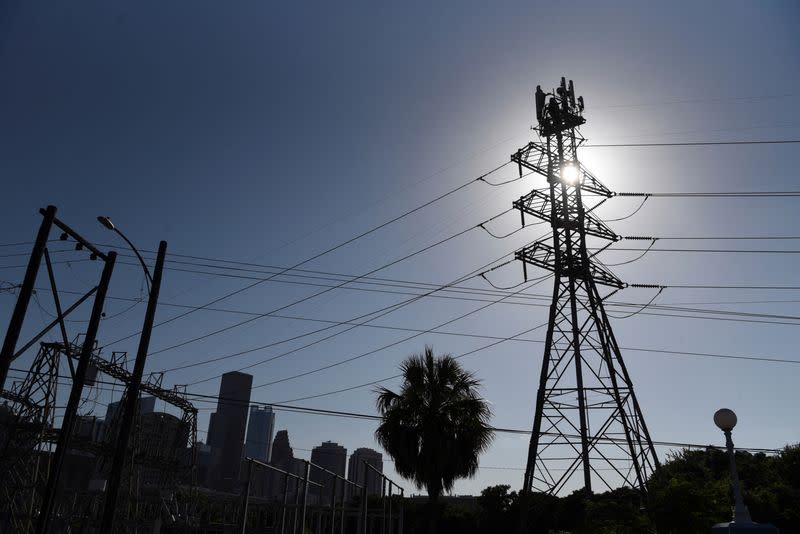US overhauls electric grid to make way for more renewables

- Oops!Something went wrong.Please try again later.
By Valerie Volcovici
WASHINGTON (Reuters) -The U.S. Federal Energy Regulatory Commission on Monday approved the first major electric transmission policy update in over a decade that aims to speed up new interregional lines to move more clean energy to meet growing demand amid the explosion of electric vehicles, data centers and artificial intelligence.
Approved in a 2-1 vote, the new rule is also the first time the FERC has ever squarely addressed the need for long-term transmission planning, playing a key role in helping meet the Biden administration's goal of decarbonizing the economy by 2050 and making the grid more resilient to more frequent climate-fueled extreme weather events.
"This rule cannot come fast enough," FERC Chairman Willie Phillips, who voted for the final rule. "There is an urgent need to act to ensure the reliability and the affordability of our grid."
"We are at a transformational moment for the electric grid with phenomenal load growth," he added, citing the surge in domestic manufacturing, proliferation of data centers, and the surge in extreme weather events that have pushed the country's ageing infrastructure to its limits.
FERC has been working for nearly two years on the rule to reform how new electric transmission gets approved and paid for, with new requirements for moving electricity across states and covering the costs of new projects.
FERC said that reforms to transmission planning received over 30,000 pages of comments, creating the largest public record ever considered by the commission.
The final rule requires transmission owners to conduct 20-year plans assessing regional electric transmission needs that would need to be revisited every five years.
It also requires transmission project participants to submit plans for how to split costs between states and companies; weigh seven specific benefits during the review process to determine whether transmission proposals will meet long-term needs cost effectively and gives operators the ability to re-evaluate projects that face cost-overruns or delays.
Before applicants submit plans, they would be required to hold a six-month engagement period with state agencies.
It also asks operators to identify opportunities to modify existing transmission facilities instead of replacing them when needed, a process known as “right-sizing” and to hold public meetings during the regional transmission planning cycle.
BEYOND FERC'S MANDATE?
President Joe Biden's administration has a goal of a carbon-free power sector by 2035, in order to fight climate change.
To meet that target, the country needs to more than double regional transmission capacity and expand interregional transmission capacity more than fivefold, a U.S. Department of Energy study said in November.
Boosted by tax incentives in Biden's 2022 Inflation Reduction Act (IRA), the queue of power generation projects awaiting a connection to the electric grid is currently around 2,600 gigawatts, twice the amount of generation of the current U.S. power plant fleet, as the grid struggles to integrate new wind, solar and battery power.
FERC Commissioner Mark Christie, who opposed the final transmission planning rule, said in his dissenting remarks that the commission rushed through the process and attempted to impose a major policy shift that favors renewables that went beyond FERC's mandate.
"This rule is a pretext to enact a sweeping policy agenda that Congress never passed," Christie said. "A policy that is intended to facilitate a massive transfer of wealth from consumers to for-profit, special interests, particularly generation developers - primarily wind and solar transmission developers and influential powerful corporations with preferences as to the types of power they want to purchase."
Republican Senator John Barrasso of Wyoming said it could make some states "foot the bill" to bring more renewable energy online and "force customers – often in rural states – to pay for new transmission lines even when those lines don’t provide any meaningful benefit to them."
All three commissioners also approved on Monday a separate but related order that would give FERC backstop siting authority to approve permits for interstate transmission projects that have been rejected or not acted upon by states.
That order also codified a code of conduct for project participants to engage with communities, conduct early outreach with Native American tribes and issue an environmental justice resource report.
"FERC’s backstop siting rule will help ensure that no one state can veto transmission lines that are in the general interest of the nation,” said Cullen Howe, a senior advocate with the Natural Resources Defense Council.
(Reporting by Valerie Volcovici; additional reporting by Nichola Groom; editing by Jonathan Oatis, Chris Reese, Susan Fenton and Marguerita Choy)

